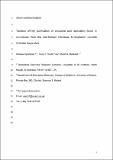Files in this item
Tandem affinity purification of exosome and replication factor C complexes from the non-human infectious kinetoplastid parasite Crithidia fasciculata
Item metadata
| dc.contributor.author | Kipandula, Wakisa | |
| dc.contributor.author | Smith, Terry K. | |
| dc.contributor.author | MacNeill, Stuart A. | |
| dc.date.accessioned | 2018-08-23T23:40:49Z | |
| dc.date.available | 2018-08-23T23:40:49Z | |
| dc.date.issued | 2017-10 | |
| dc.identifier | 250869320 | |
| dc.identifier | 4ed89c6a-c70b-4b3c-ae7e-e62c1a2187d3 | |
| dc.identifier | 85028384732 | |
| dc.identifier | 000413796000005 | |
| dc.identifier.citation | Kipandula , W , Smith , T K & MacNeill , S A 2017 , ' Tandem affinity purification of exosome and replication factor C complexes from the non-human infectious kinetoplastid parasite Crithidia fasciculata ' , Molecular and Biochemical Parasitology , vol. 217 , pp. 19-22 . https://doi.org/10.1016/j.molbiopara.2017.08.004 | en |
| dc.identifier.issn | 0166-6851 | |
| dc.identifier.other | ORCID: /0000-0002-0555-0007/work/39107863 | |
| dc.identifier.uri | https://hdl.handle.net/10023/15871 | |
| dc.description | This work was supported through the Global Health Implementation programme at the University of St Andrews. | en |
| dc.description.abstract | Kinetoplastid parasites are responsible for a range of diseases with significant global impact. Trypanosoma brucei and Trypanosoma cruzi cause human African trypanosomiasis and Chagas disease, respectively, while various Leishmania species are responsible for cutaneous, mucocutaneous and visceral leishmaniasis. Understanding the biology of these organisms is key for effective diagnosis, prophylaxis and treatment. The insect parasite Crithidia fasciculata offers a safe and low-cost alternative for studies of kinetoplastid biology. C. fasciculata does not infect humans, can be cultured to high yields in inexpensive serum-free medium in a standard laboratory, and has a completely sequenced publically available genome. Taking advantage of these features, however, requires the adaptation of existing methods of analysis to C. fasciculata. Tandem affinity purification is a widely used method that allows for the rapid purification of intact protein complexes under native conditions. Here we report the application of tandem affinity purification to C. fasciculata for the first time, demonstrating the effectiveness of the technique by purifying both the intact exosome and replication factor C complexes. Adding tandem affinity purification to the C. fasciculata toolbox significantly enhances the utility of this excellent model system. | |
| dc.format.extent | 4 | |
| dc.format.extent | 434391 | |
| dc.language.iso | eng | |
| dc.relation.ispartof | Molecular and Biochemical Parasitology | en |
| dc.subject | Crithidia fasciculata | en |
| dc.subject | Tandem affinity purification | en |
| dc.subject | Kinetoplastid | en |
| dc.subject | Exosome | en |
| dc.subject | DNA replication | en |
| dc.subject | QH301 Biology | en |
| dc.subject | QR Microbiology | en |
| dc.subject | RC Internal medicine | en |
| dc.subject | NDAS | en |
| dc.subject | SDG 3 - Good Health and Well-being | en |
| dc.subject.lcc | QH301 | en |
| dc.subject.lcc | QR | en |
| dc.subject.lcc | RC | en |
| dc.title | Tandem affinity purification of exosome and replication factor C complexes from the non-human infectious kinetoplastid parasite Crithidia fasciculata | en |
| dc.type | Journal article | en |
| dc.contributor.institution | University of St Andrews. School of Biology | en |
| dc.contributor.institution | University of St Andrews. Biomedical Sciences Research Complex | en |
| dc.identifier.doi | 10.1016/j.molbiopara.2017.08.004 | |
| dc.description.status | Peer reviewed | en |
| dc.date.embargoedUntil | 2018-08-24 | |
| dc.identifier.url | http://www.sciencedirect.com/science/article/pii/S0166685117300890#appd002 | en |
This item appears in the following Collection(s)
Items in the St Andrews Research Repository are protected by copyright, with all rights reserved, unless otherwise indicated.

